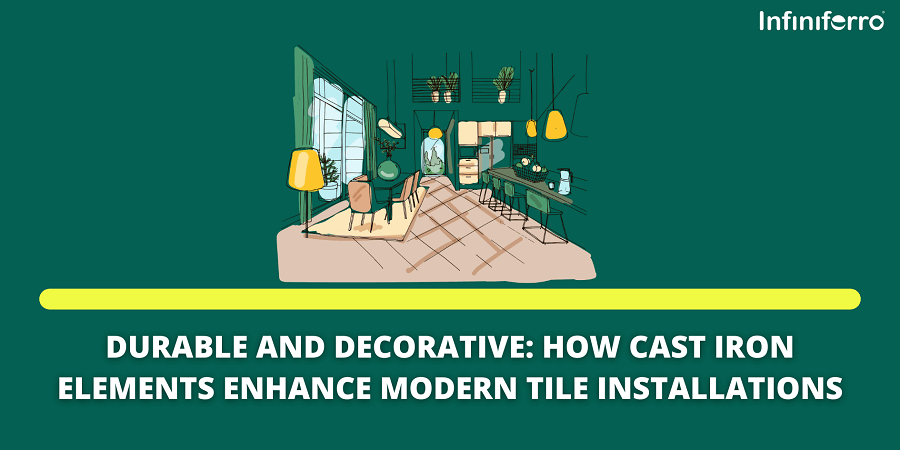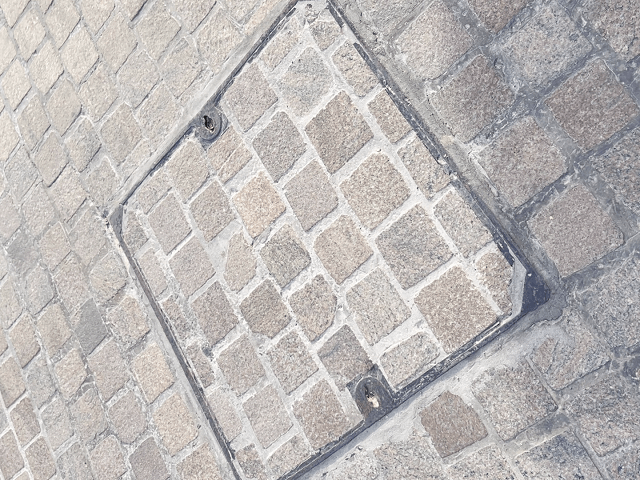
In the ever-evolving world of interior and exterior design, the fusion of durability and aesthetic appeal has become a top priority. Designers and homeowners alike are seeking materials that not only withstand the test of time but also contribute to the visual character of a space. One of the emerging trends that meets both of these criteria is the integration of cast iron elements in modern tile installations. This trend blends the industrial charm of cast iron with the elegance and versatility of tile work, resulting in installations that are both resilient and refined.
This article explores how cast iron enhances tile projects in various settings, from kitchens and bathrooms to outdoor patios and commercial spaces. We’ll delve into its durability, visual impact, and functional advantages, while also offering insights into how to incorporate it effectively. Along the way, we’ll discuss the role of materials like mosaic tiles and where you can buy mosaic tiles online to complement your cast iron-enhanced designs.
The Timeless Appeal of Cast Iron
Cast iron has a long and storied history in architecture and design. From ornate Victorian fences and lamp posts to robust cookware and fireplace grates, cast iron is renowned for its strength, longevity, and distinct aesthetic. It offers a look that is simultaneously historic and industrial, a quality that has made it a popular material in restoration projects and contemporary minimalist interiors alike.
But beyond its classic applications, cast iron is making a bold return in new ways, especially in tile design. Modern fabrication techniques have expanded their usage, allowing cast iron to be shaped, textured, and finished in ways that pair seamlessly with ceramic, porcelain, stone, and mosaic tiles.
Why Choose Cast Iron in Tile Installations?
1. Unmatched Durability
One of the primary reasons to integrate cast iron into tile installations is its exceptional strength and longevity. Cast iron is incredibly resistant to wear, impact, and high temperatures, making it ideal for high-traffic areas or spaces exposed to moisture and heat.
For example, cast iron inlay grilles embedded in floor tile layouts can withstand the constant pressure of foot traffic while adding a decorative focal point. In kitchens or fireplaces, cast iron trim or panels provide heat-resistant surfaces that maintain their integrity over time, unlike plastics or softer metals that may degrade.
2. Architectural Sophistication
Cast iron carries an architectural weight that few materials can match. Whether it’s an intricate grate embedded in a tiled floor, a stylized corner detail, or a decorative transition strip, cast iron adds visual structure and historic gravitas to a space.
In bathrooms, cast iron vent covers or tile surrounds offer a bold contrast against smooth ceramics or glass tiles. In outdoor patios, cast iron medallions or edge trims combined with natural stone tiles contribute to a rustic yet elevated aesthetic.
3. Design Flexibility
Modern casting techniques allow cast iron elements to be produced in a wide variety of shapes, patterns, and textures. From traditional floral motifs to geometric modernism, designers can choose from a broad catalog—or even create custom molds—for a look that complements any tile type.
Pairing cast iron with tiles such as subway tiles, encaustic cement tiles, or glass mosaics opens up exciting design possibilities. You might integrate a patterned cast iron strip between rows of tile as a decorative divider or use custom iron inlays within a mosaic to highlight a feature area like a backsplash or shower niche.
Cast Iron and Mosaic Tiles: A Perfect Pair
While cast iron works well with many tile types, it pairs especially beautifully with mosaic tiles. The intricate patterns of mosaics—whether stone, glass, or ceramic—offer a delicate contrast to the bold solidity of cast iron. Together, they create a rich interplay of texture, color, and form.
Contrasting Textures and Materials
Mosaic tiles often bring luminosity and fine detail to a space. A shimmering glass mosaic can lighten a room, while a matte stone mosaic introduces a tactile quality. When bordered or interspersed with cast iron elements, these textures pop even more.
Imagine a bathroom wall featuring a glass mosaic accent panel framed by narrow cast iron borders with subtle scrollwork. The result is a centerpiece that captures light, adds depth, and anchors the space visually.
Custom Inserts and Medallions
Cast iron medallions or inserts designed to fit within mosaic fields can serve as artistic focal points. These inserts may feature custom initials, logos, or artistic motifs, making them popular in luxury residential designs or boutique commercial spaces.
For example, a hotel lobby with a mosaic floor may include a centrally placed cast iron medallion bearing the establishment’s logo, creating a permanent and eye-catching brand element.
Practical Applications of Cast Iron in Tile Installations
The fusion of cast iron and tile isn’t just about looks. It serves practical functions that contribute to the longevity and usability of spaces. Here are several practical applications where cast iron plays a pivotal role:
1. Drain Covers and Vent Grilles
Cast iron drain covers embedded into shower floors or tiled courtyards provide both functionality and design. These covers can be laser-cut with unique patterns and are extremely resistant to rust when properly finished.
Another drainage cover, the recessed manhole cover has a unique design; there is space on the surface to install tiles. Thus, the manhole cover can be disguised and people are not too aware that there is a drainage channel there.
Vent grilles in tiled floors or walls can be designed to align with tile patterns, contributing to a seamless and intentional aesthetic rather than a utilitarian afterthought.
2. Thresholds and Transitions
In places where tile meets another flooring material, such as wood or carpet, a cast iron threshold strip adds durability while clearly defining the transition. These strips are especially useful in high-traffic commercial spaces like restaurants or galleries, where foot traffic is intense and style matters.
3. Fireplace and Stove Surrounds
For tiled hearths and fireplace surrounds, cast iron is a logical and stylish companion. Its resistance to heat and timeless look make it ideal for framing or backing tile installations around wood stoves or open fireplaces.
Maintenance and Longevity
One concern with using metal elements in wet or humid environments is corrosion. Fortunately, modern treatments for cast iron, such as powder coating, enameling, or oil-rubbed finishes, offer excellent protection against rust and wear.
In most tile installations, the cast iron pieces are not exposed to standing water for prolonged periods, reducing the risk of corrosion. Routine maintenance involves occasional cleaning and inspection, with the option of recoating over the years to maintain appearance.
How to Source Cast Iron Elements and Complementary Tiles
Sourcing quality cast iron components for tile installations is easier than ever. A growing number of specialty manufacturers and artisans offer cast iron inlays, grilles, trims, and medallions in both stock and custom designs. Many tile retailers now partner with these manufacturers to provide complete installation packages.
Equally important is selecting the right tile to accompany your cast iron accents. For those seeking variety and convenience, it’s often best to buy mosaic tiles online from reputable retailers. Online platforms offer access to a wide range of styles, colors, and materials—from classic Carrara marble to modern metallic-finish glass mosaics—making it simple to find the perfect match for your project.
When shopping online, look for vendors that offer:
- High-resolution product images
- Samples before purchase
- Detailed specifications (thickness, finish, material)
- Customer reviews
- Easy shipping and return policies
Design Ideas and Inspiration
Here are a few ways to creatively integrate cast iron into your tile installations:
1. Vintage Bathroom Makeover
Create a nostalgic, Victorian-inspired bathroom by combining white hexagonal mosaic tiles with cast iron vent grilles, claw-foot tub legs, and mirror frames. Black cast iron elements provide bold contrast and sophistication.
2. Art Deco Kitchen Backsplash
Pair angular mosaic tiles in brass and navy with custom cast iron trim in a sunburst or stepped design. The result is a luxe, 1920s-inspired focal wall behind the range or sink.
3. Modern Rustic Fireplace
Use large-format slate tiles around a fireplace opening and frame the surround with cast iron panels featuring nature-inspired motifs. Add a matching cast iron log grate for cohesion.
4. Outdoor Garden Path
Combine natural stone tiles or pavers with cast iron inserts along a garden path. These can feature floral or geometric designs that weather beautifully over time.
5. Industrial Loft Shower Wall
Install glass subway tiles and intersperse with horizontal cast iron bars or linear grilles. Add matching hooks and fixtures to complete the rugged, industrial home vibe.
Conclusion
The resurgence of cast iron in modern tile installations is more than a fleeting trend—it’s a testament to the enduring appeal of combining form and function. Cast iron brings unmatched durability, design richness, and a sense of heritage to any tiled space. Whether you’re designing a rustic retreat, a vintage-inspired powder room, or a sleek urban kitchen, cast iron can elevate your tile installation from standard to stand out.
By thoughtfully integrating cast iron elements and selecting high-quality tiles—especially mosaics—you can create designs that are both durable and decorative. And thanks to the convenience of e-commerce, it’s easier than ever to buy mosaic tiles online and find just the right textures and finishes to complement your vision.
ALSO READ:


Leave a Reply